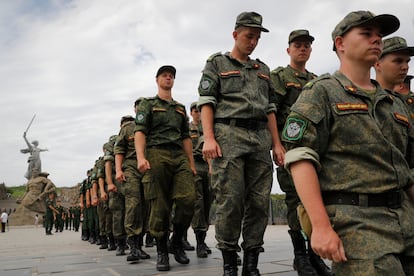Ukraine war: Putin to increase size of Russian army by more than 130,000
The decree will increase the total number of personnel in the armed forces to 2.03 million, but experts warn recruitment campaigns have failed to beef up the military’s ranks


Half a year after the start of Russia’s so-called “special military operation” in Ukraine, Russian President Vladimir Putin has issued a decree to increase the size of the Russian armed forces by 137,000, assigning whatever budget is necessary to continue funding his war machine.
The decree will go into effect on January 1, 2023. It increases the total personnel of the Russian armed forces, including non-combatants, to 2.03 million people. The Ministry of Defense will have to enlist more than 130,000 new combatants. This will bring the number of military personnel to 1,150,628 soldiers, a 13% increase on the current limit (1,013,628).
Putin’s decree does not explain the reasons for the measure. Until now, the Russian army had been reinforced in Ukraine with the recruitment of volunteers through private security companies and the forced mobilization of men in the controlled territories, particularly in the Donetsk and Luhansk regions. These combatants, however, have not yet been recognized as part of the armed forces.
The last time Putin altered the size of his army was in November 2017. His preparation for the move included other legal reforms, including a February norm that established the dimensions that mass graves should have.
“I decree that the Government of the Russian Federation provide for the Ministry of Defense the allocation of the federal budget that is necessary to carry out this order,” reads the presidential order signed by Putin. The exact budget expenditure is unknown: since the war began, most public spending items have not been revealed by the Kremlin.

Against recruitment
Military service is compulsory in Russia, but the armed forces are legally constituted as a professional army. Theoretically, only those who have signed an employment contract can participate in wars outside its borders. However, the Ministry of Defense recognized that several people completing their service were illegally sent to the front. “Measures are being taken to prevent recruits from being sent to combat zones,” defense spokesman Igor Konashenkov said in March.
The authorities have launched numerous recruitment campaigns in recent months, especially in the less affluent regions of Russia, where most of the members of the armed forces come from, as it provides them with a stable job and income.
This has not been enough, though, and the Kremlin has passed several reforms in recent months to boost enlistment. One reform abolished the age restrictions on enlistment, previously limited to 18 to 40-year-old Russians and foreigners under 30. The new soldiers will also be able to sign their first contract once they finish school and without needing any additional training.
Likewise, Putin announced at the beginning of March a payment of seven million rubles to the families of combatants killed in Ukraine, and another of three million rubles to the wounded. The median salary for soldiers was around 62,457 rubles in May, according to the Russian statistics agency Rosstat.
The fear of being sent to war is palpable, though, and this affected the last recruitment campaign. Every year, there are two rounds of recruitment for military service, which target Russians between the ages of 18 and 27 years. This spring’s round, which was open from April 1 to July 15, seems to have been a failure. Defense Minister Sergei Shoigu announced on July 11 that some 89,000 recruits had been sent to the armed forces, when the total number expected was around 134,500 members.
“Only one fifth to one third of the planned number of recruits were sent to the troops by mid-June, although normally at least a half of the recruits are sent to the army by this time,” says Pavel Luzin, specialist in Russian armed forces, on the website of the think tank Riddle.
“Under these circumstances, one could assume that the autumn draft campaign, which starts on October 1 and runs till December 31, should be stricter, leaving fewer loopholes for those trying to avoid military service,” adds the expert. He estimates that with the casualties already suffered in Ukraine, the Russian army has several hundred thousand fighters less than its nominal strength of one million troops, which “will inevitably lead to an aggravation of the already serious organizational problems and disruptions.”
Tu suscripción se está usando en otro dispositivo
¿Quieres añadir otro usuario a tu suscripción?
Si continúas leyendo en este dispositivo, no se podrá leer en el otro.
FlechaTu suscripción se está usando en otro dispositivo y solo puedes acceder a EL PAÍS desde un dispositivo a la vez.
Si quieres compartir tu cuenta, cambia tu suscripción a la modalidad Premium, así podrás añadir otro usuario. Cada uno accederá con su propia cuenta de email, lo que os permitirá personalizar vuestra experiencia en EL PAÍS.
¿Tienes una suscripción de empresa? Accede aquí para contratar más cuentas.
En el caso de no saber quién está usando tu cuenta, te recomendamos cambiar tu contraseña aquí.
Si decides continuar compartiendo tu cuenta, este mensaje se mostrará en tu dispositivo y en el de la otra persona que está usando tu cuenta de forma indefinida, afectando a tu experiencia de lectura. Puedes consultar aquí los términos y condiciones de la suscripción digital.
More information
Últimas noticias
Most viewed
- Oona Chaplin: ‘I told James Cameron that I was living in a treehouse and starting a permaculture project with a friend’
- Reinhard Genzel, Nobel laureate in physics: ‘One-minute videos will never give you the truth’
- Sinaloa Cartel war is taking its toll on Los Chapitos
- Why the price of coffee has skyrocketed: from Brazilian plantations to specialty coffee houses
- Chevy Chase, the beloved comedian who was a monster off camera: ‘Not everyone hated him, just the people who’ve worked with him’










































